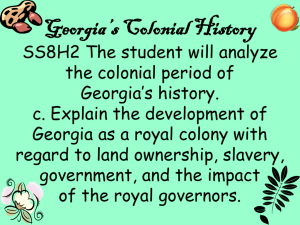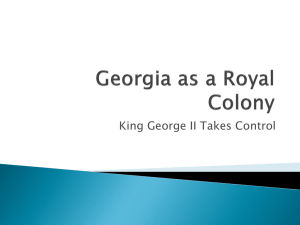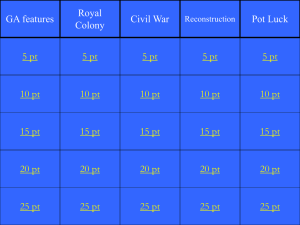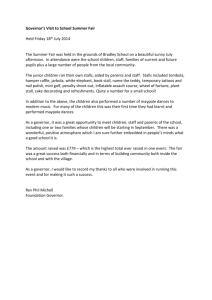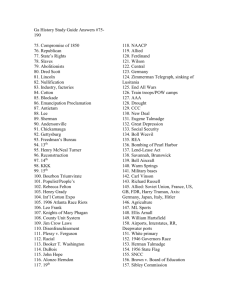Development of Georgia as a Royal Colony
advertisement
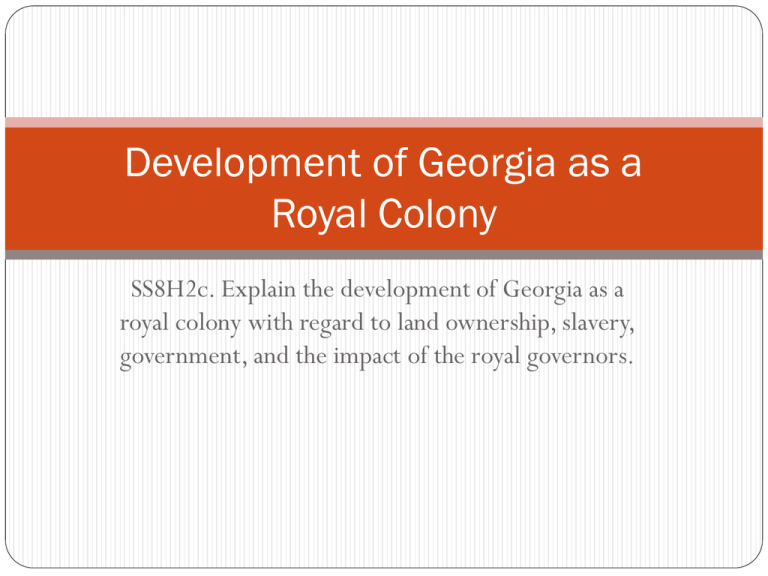
Development of Georgia as a Royal Colony SS8H2c. Explain the development of Georgia as a royal colony with regard to land ownership, slavery, government, and the impact of the royal governors. John Reynolds Date: 11/1/1754 First Royal Governor Introduced the idea of self- government Bicameral legislature Lower house called Commons House of Assembly Members had to own at least 500 acres of land Upper house called Governor’s Council Members were appointed by the king of England Set up a court system Colonists took cases before the Court of Conscience If it could not be settled went to Governor’s Council New government met for the first time in 1755 in Savannah Reorganized the state militia Passed bills to build roads Drew up code that restricted the rights of slaves John Reynolds Things went well for awhile, then during one legislative session, members of the Governor’s Council could not agree on how much was needed to improve the military defenses of the colony. Reynolds became so angry that he sent the legislators home. During the months that followed he tried to govern Georgia by himself. This made the colonists angry. Many Georgians did not like having their right to selfgovernment taken away and wrote to King George to complain. John Reynolds The final straw was Reynolds’ recommendation to move Savannah to the Ogeechee River. After two years, the group who wanted self-government won and John Reynolds was replace. Review What city served as Georgia’s capital during its period as a royal colony? 2. Who was the first royal governor of Georgia? 3. When Georgia was a royal colony, how were members of the upper house of the legislature, the governor’s council, chosen? 1. Review What city served as Georgia’s capital during its period as a royal colony? 1. Savannah Who was the first royal governor of Georgia? 2. John Reynolds When Georgia was a royal colony, how were members of the upper house of the legislature, the governor’s council, chosen? 3. They were appointed by the king. Review 4. While John Reynolds was its royal governor, Georgia established… 5. Governor Reynolds disbanded the legislature because … Review 4. While John Reynolds was its royal governor, Georgia established… Bicameral legislature Court system 5. Governor Reynolds disbanded the legislature because … There was a disagreement over how to improve military defenses. Governor Henry Ellis Appointed February 1757 Naturalist and scientist Learned from Reynolds mistakes Brought together people from many different political groups Sought the advise of the Governor of South Carolina Depended on well-known and wealthy citizens to lead During his 3 years as governor New colonists came from South Carolina and the West Indies Many brought slaves and were granted large amounts of land By 1759 the population had grown to 10,000 3,600 of which were slaves Governor Henry Ellis Ellis was a popular governor and the colony made many economic gains under his direction. More and profitable farms More merchants with a greater variety of items to sell Allowing colonists to buy things they couldn’t grow like: cloth, sugar, farming tools and seeds. In 1759 Ellis became ill and asked to return to Great Britain. Review Who was the second royal governor of Georgia? 2. What changes were brought about during his term as royal governor? 1. Review Who was the second royal governor of Georgia? Henry Ellis 2. What changes were brought about during his term as royal governor? More profitable farms Increased population Increased availability of goods 1. Governor James Wright Born in Charleston; educated in Great Britain Arrived October 11, 1760 Previously served as attorney general in South Carolina for 21 years Loyal to the king, but wanted colonies to do well Agreed with selfgovernment Believed that Georgia would continue to grow if Larger farms were even bigger Trading expanded Western lands of the colony were opened to settlers. Governor James Wright During his early years as governor: Completed the defenses around Savannah Surrounded by palisades Forts made stronger The town of Sunbury grew and became the colony’s official port of entry for ships Both houses of the legislature worked together to promote Georgia’s economic growth. Farmers were allowed to borrow more money, so they bought more land. The amount of land owned grew from 1 million acres to 7 million acres. Rice and indigo became profitable crops. Enough silk was produced that by 1767 a ton of it was exported. More schools were built More people were reading so more books were sold 1763 the colony’s first newspaper, The Georgia Gazette, was started Many of the small original houses were replaced by twostory houses built from wood or tabby. Governor James Wright There was, however, another side to Georgia during these early years. Many mothers died in childbirth School was mostly for children in the upper economic class. A group of what the plantation owners called “undesirable people” moved from Virginia and the Carolinas to settle in the middle and western parts of the colony. These people became known as “crackers” The term may have come from the cracking sounds of whips used on oxen or horses on the way to market to sell their goods It may have come from the cracking of corn in the preparation of corn meal. Some say it was a Scottish term for “boasters”. No matter how it started, the term was meant as an insult for the lower classes. Crackers were thought of as people who did not obey the law and were not welcome.
